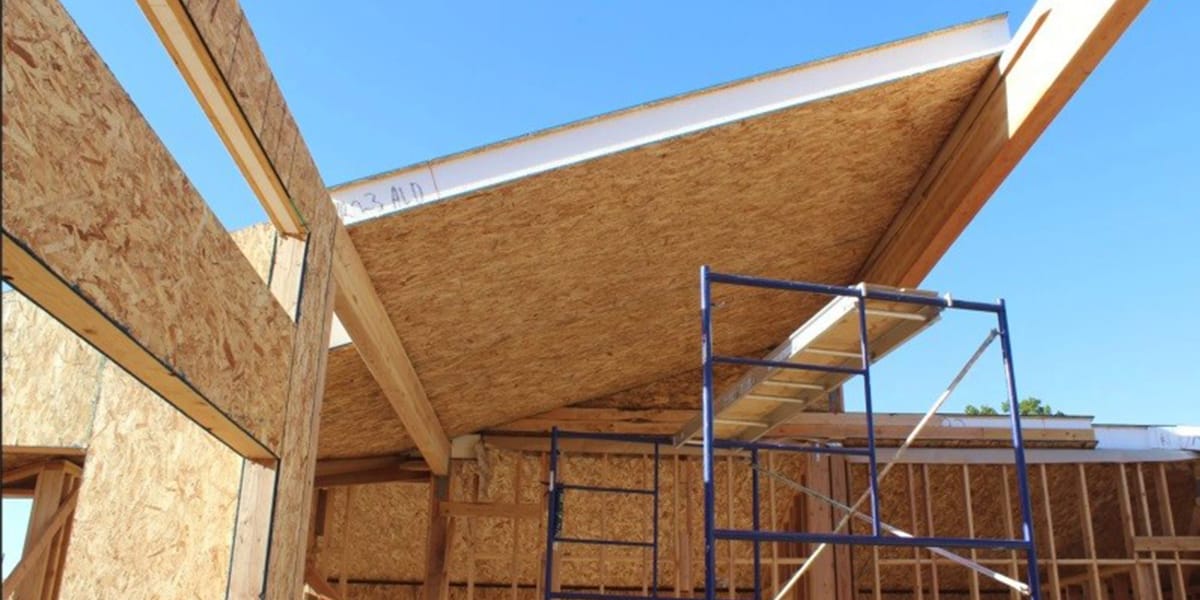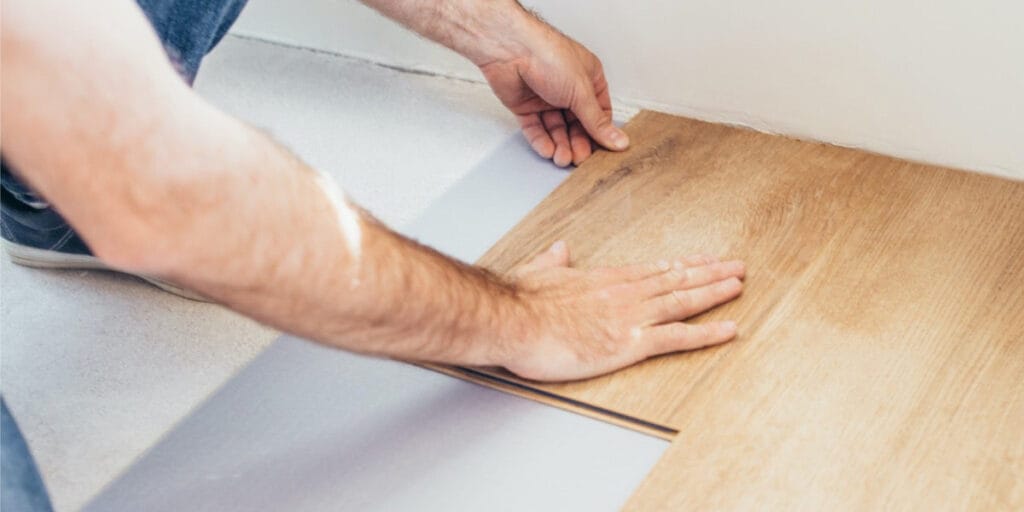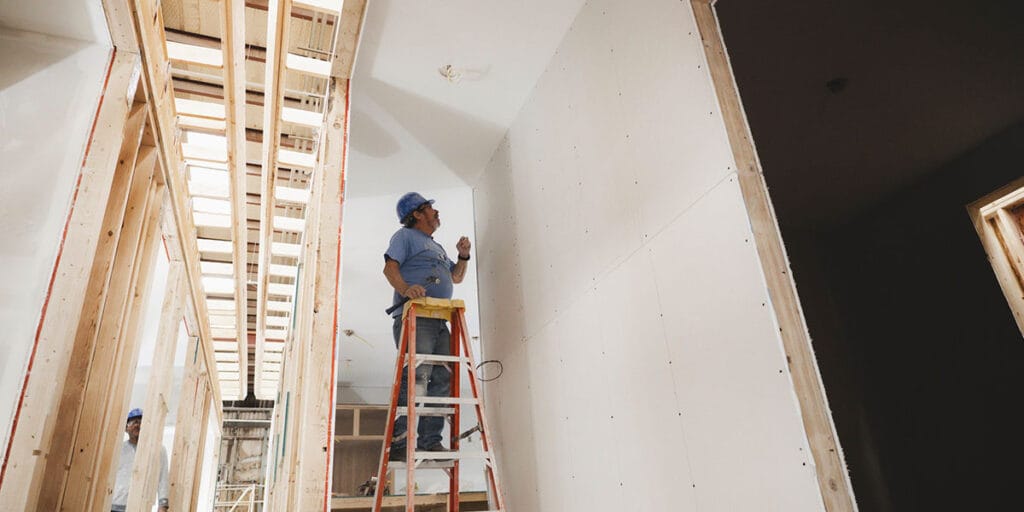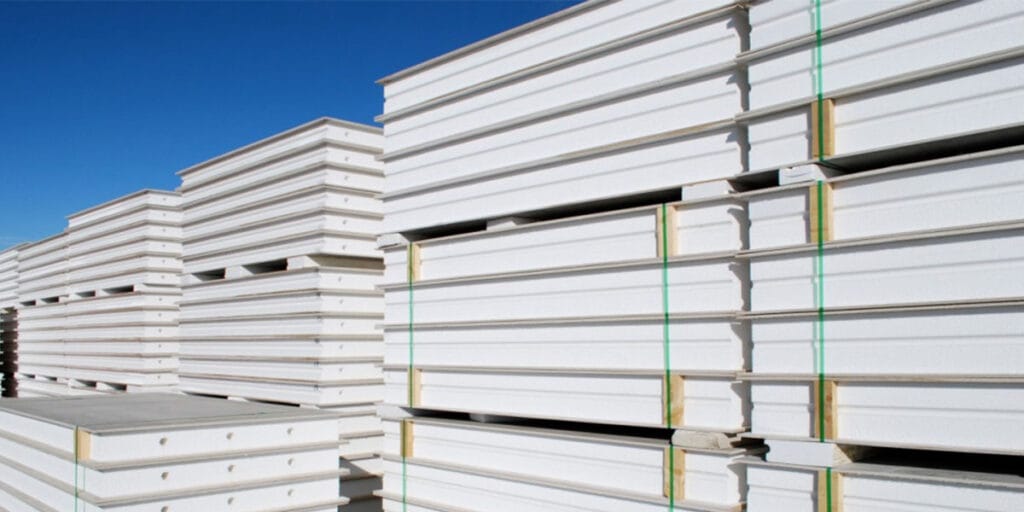
19 Jun Particle Board Wall Sheathing Alternatives
Table of Contents
- 1 Key Takeaways
- 2 OSB (Oriented Strand Board) as a Particle Board Alternative
- 3 Plywood for Exterior Wall Sheathing
- 4 Fiberboard as an OSB Alternative
- 5 Gypsum Board for Wall Sheathing
- 6 Magnesium Board for Exterior Wall Sheathing
- 7 Cement Board as a Strong Sheathing Choice
- 8 Structural Insulated Panels (SIPs) as an OSB Alternative
- 9 Comparison of Particle Board Alternatives
- 10 FAQ
- 10.1 What is the best alternative to particle board for exterior walls?
- 10.2 Can structural insulated panels (SIPs) replace traditional wall sheathing?
- 10.3 Are plywood and OSB suitable for humid climates?
- 10.4 How do I choose the right sheathing material for my project?
- 10.5 Are there eco-friendly options for wall sheathing?
Particle board has been used in building for a long time. However, it has problems that make it less useful for many jobs. It does not handle moisture well, which causes it to swell and break down when wet or in humid air. It is also not as strong as other materials. For example, tests show its strength and bonding ability drop a lot in bad weather, sometimes by 50% when WI values are as low as 50 × 10^3. These issues lead to higher costs over time because of repairs and replacements.
To solve these problems, builders now use better materials that last longer. Choices like OSB, plywood, fiberboard, gypsum board, magnesium board, cement board, and SIPs resist moisture and water while being stronger. These materials improve building methods and save money in the long run, making them great for eco-friendly projects.
Key Takeaways
Use OSB or plywood for strong and water-resistant projects. They last longer and are tougher than particle board.
Pick cement board or magnesium board for outside walls in rainy areas. These materials fight off water, mold, and bugs well.
Structural Insulated Panels (SIPs) work great for saving energy. They combine insulation and strength, cutting down energy bills.
Choose fiberboard for indoor projects needing a smooth surface. It’s cheap but not good for heavy or wet use.
Always pick the right sheathing for your weather and project. This helps it work better and last longer.
OSB (Oriented Strand Board) as a Particle Board Alternative
What is OSB?
OSB stands for Oriented Strand Board. It is a type of engineered wood made by pressing wood strands together with glue. The strands are placed in specific directions to make the board stronger and more durable. OSB is often used in building because it provides strong support. Unlike particle board, OSB can handle heavier weights and does not bend easily under pressure.
Tip: OSB is a better choice than particle board for projects needing strength and water resistance.
Pros and Cons of OSB
Pros:
Strength and Durability: OSB is stronger than particle board, making it great for heavy-duty use.
Moisture Resistance: OSB resists water better than particle board. It swells less and stays strong when wet.
Fastener Holding: OSB holds screws and nails tightly, keeping structures secure.
Cost-Effectiveness: OSB costs more upfront but lasts longer, saving money over time.
Cons:
Moisture Susceptibility: OSB can swell if exposed to water for too long.
Environmental Impact: Making OSB uses more energy, which affects the environment.
Insulation Value: OSB does not insulate as well as some other materials.
Aspect | OSB | Particle Board |
|---|---|---|
Strength | Stronger than particle board | Weaker than OSB |
Moisture Resistance | Poor water resistance | |
Cost | More expensive | Less expensive |
Environmental Impact | Higher due to processing | Lower than OSB |
Best Applications for OSB
OSB is a flexible material used in many ways. In homes, it is often used for walls, roofs, and floors. Its strength makes it a top choice for tough building jobs. In Asia-Pacific, OSB is popular for eco-friendly construction and city projects. In Europe, it is used for packaging that is strong and good for the environment. In Latin America, it helps meet the need for affordable housing.
Region | Application Area | Key Insights |
|---|---|---|
Asia-Pacific | Construction | OSB is used for green building and city projects. |
Europe | Packaging | OSB is chosen for strong, eco-friendly packaging. |
Latin America | Residential Construction | OSB supports affordable housing and home projects. |
Middle East & Africa | Construction | OSB demand is growing in Saudi Arabia’s building sector. |
Note: Think about the weather and moisture levels before using OSB for your project.
Plywood for Exterior Wall Sheathing

What is Plywood?
Plywood is a strong material made by gluing thin wood layers. These layers, called plies, are placed in opposite grain directions. This pattern makes plywood sturdy and less likely to bend or crack. Unlike solid wood, plywood stays stable even in changing weather. It is often used in construction because it can handle heavy loads.
Tip: Plywood comes in many grades. Pick the right one for indoor or outdoor projects.
Pros and Cons of Plywood
Pros:
Durability and Stability: Plywood stays strong and doesn’t warp in tough conditions.
Moisture Resistance: It works well in wet places like kitchens and bathrooms.
Cost-Effectiveness: Plywood is affordable and lasts a long time.
Structural Strength: Its layered design makes it great for heavy-duty tasks.
Cons:
Moisture Sensitivity: Plywood needs sealing to last longer outdoors.
Surface Finish: It may need sanding or painting for a smooth look.
Environmental Impact: Making plywood uses trees, which affects forests.
Factor | Plywood | Real Wood |
|---|---|---|
Built to avoid warping | Can crack or change shape | |
Moisture Resistance | Good for wet areas | Needs sealing to stay safe |
Cost & Value | Affordable and long-lasting | Expensive but adds home value |
Best Applications for Plywood
Plywood is useful for many projects because it is strong and water-resistant. Outdoor plywood works well for wall sheathing and stays solid in dry weather. It also holds up in freezing temperatures without breaking.
Inside homes, plywood is great for shelves, vanities, and walls in damp rooms like bathrooms. It doesn’t warp or rot, making it a smart choice for modern designs. Special types, like Teak Ply, offer both style and function.
In building projects, plywood is used for floors, roofs, and walls. It gives support and protects against weather. Moisture-resistant plywood is perfect for basements, coastal homes, and tropical areas. It stops mold and mildew from growing. Public buildings and modern designs also use plywood because it is strong and flexible.
Note: Choose the right plywood type to make your project last longer.
Fiberboard as an OSB Alternative
What is Fiberboard?
Fiberboard is a type of engineered wood made by pressing wood fibers with glue. It comes in three types: low-density (LDF), medium-density (MDF), and high-density (HDF). MDF is the most popular and is often used in furniture and construction. Its surface is smooth, making it easy to paint or finish. Unlike natural wood, fiberboard has no knots or grain, so it’s simpler to work with.
Tip: Use fiberboard for projects needing a flat, smooth surface.
Pros and Cons of Fiberboard
Pros:
Versatile Use: Fiberboard works for both decorative and basic building needs.
Smooth Finish: Its surface is perfect for painting or adding designs.
Eco-Friendly Choices: Some types, like MDF with special materials, save energy.
Budget-Friendly: Fiberboard costs less than plywood or OSB.
Cons:
Water Issues: Fiberboard can swell or weaken if it gets wet.
Weaker Strength: It’s not as strong as plywood or OSB for heavy jobs.
Shorter Lifespan: It may not last long in tough or outdoor conditions.
Feature | Fiberboard | OSB or Plywood |
|---|---|---|
Surface Finish | Smooth and easy to paint | May need sanding or extra work |
Moisture Resistance | Poor unless sealed | Handles water better |
Cost | Cheaper | Costs a bit more |
Best Applications for Fiberboard
Fiberboard is great for indoor projects and light-duty uses. It’s often used for furniture, cabinets, and wall panels because of its smooth surface. MDF with special materials can store heat, making it useful in homes with extreme weather.
For lightweight sheathing, fiberboard is a good, affordable option. It’s perfect for walls, ceilings, and partitions that don’t need to hold heavy loads. Its eco-friendly versions are also popular for green building projects.
Note: Don’t use fiberboard in wet areas or for heavy-duty tasks.
Gypsum Board for Wall Sheathing
What is Gypsum Board?
Gypsum board, or drywall, is a light material used in building. It has a gypsum core covered by two paper sheets. Builders like it because it’s easy to install and very useful. It comes in different thicknesses and types, like fire-resistant and moisture-resistant boards. These special boards are made to handle specific needs, making them a smart choice for modern buildings.
Tip: Pick the right gypsum board for your project. Use fire-rated boards for safety or moisture-resistant ones for wet areas.
Pros and Cons of Gypsum Board
Pros:
Gypsum board is great for fire safety in buildings.
Special panels resist mold and moisture in damp places.
It’s easy to install, saving time and effort.
Stronger panels last longer and need less fixing over time.
Cons:
Some builders don’t know about advanced gypsum boards.
Without learning, they miss out on these better options.
Feature | Gypsum Board | Particle Board |
|---|---|---|
Fire Resistance | Very high | Very low |
Moisture Resistance | Good with special panels | Poor |
Ease of Installation | Fast and easy | Takes more time |
Best Applications for Gypsum Board
Gypsum board is perfect for inside walls in homes and offices. Use it for ceilings, partitions, and walls in schools, houses, or workplaces. Its fire-resistant type is great for kitchens or utility rooms. Moisture-resistant boards work well in bathrooms and basements with high humidity.
It also gives a smooth surface for painting or decorating. Gypsum board is good for soundproofing, keeping rooms quiet and private. For eco-friendly projects, choose boards made from recycled materials to help the environment.
Note: Always check the gypsum board’s details to make sure it fits your project’s needs.
Magnesium Board for Exterior Wall Sheathing

What is Magnesium Board?
Magnesium board, or MgO board, is a strong and lightweight material. It is made from magnesium oxide, a mineral that gives it special features. This board is easy to use and works well for exterior walls. Unlike other materials, it resists fire, water, mold, and pests. These qualities make it great for tough environments.
Magnesium board comes in different sizes and thicknesses. You can pick the one that fits your project. It is also non-toxic, making it safer for homes and buildings.
Tip: Check the manufacturer’s details to ensure the board fits your project’s needs.
Pros and Cons of Magnesium Board
Pros:
Water Resistance: It works well in wet places and humid weather.
Fireproof Qualities: It offers great fire protection for buildings.
Mold and Pest Resistance: It stops mold and keeps insects away.
Lightweight and Easy to Install: It is light, so it’s quicker to install.
Cons:
Fastener Compatibility: Some metal fasteners may rust in wet areas.
Higher Initial Cost: It costs more than other wall materials.
Magnesium board is strong and handles tough conditions well. But you need to choose the right fasteners and think about its long-term value.
Best Applications for Magnesium Board
Magnesium board is perfect for homes and special projects. Its fireproof and water-resistant features make it ideal for schools and safe buildings. Here’s how it compares to cement board:
Application Scenario | Advantages of Magnesium Board | |
|---|---|---|
Residential Construction | Non-toxic, fire, mold, and moisture resistant; lightweight for easy handling and quick installation | Often used in industrial settings for impact resistance |
Specialty Projects (e.g., schools) | Enhanced fire ratings, suitable for structures requiring high safety standards | Cement board is less effective in fire-rated applications |
For exterior walls, magnesium board is great in wet or extreme weather. It’s also eco-friendly because it’s non-toxic and recyclable.
Note: Choose magnesium board when safety and durability are most important.
Cement Board as a Strong Sheathing Choice
What is Cement Board?
Cement board is a solid material made from cement and fibers. It is built to handle tough conditions, making it great for outside walls. Unlike wood materials, it resists water, mold, and pests. It also protects against fire, adding safety to buildings. You can use it in wet or extreme weather areas without worrying about damage.
Tip: Use cement board for projects needing strength and water resistance.
Pros and Cons of Cement Board
Pros:
Moisture Resistance: It doesn’t soak up water, so it won’t rot.
Durability: It stays strong in bad weather without breaking.
Fire Safety: It has a low flame spread and smoke rating, making it safe.
Mold Resistance: It performs well in mold tests, lasting a long time.
Cost Efficiency: Though costly upfront, it saves money on repairs later.
Cons:
Moisture Absorption: Fiber cement siding may swell or crack in humid areas.
Maintenance Needs: It needs painting or sealing to stay in good shape.
Cost: Installing fiber cement siding can be expensive compared to vinyl.
Advantage | Description |
|---|---|
Moisture Resistance | PermaBASE cement board doesn’t soak water, so it won’t rot. |
Durability | Built to handle outdoor weather without falling apart. |
Mold Resistance | High scores in mold tests ensure long-lasting use. |
Cost Efficiency | Saves money over time by cutting labor and repair costs. |
Note: Cement board can last over 50 years with proper care, making it worth the investment.
Best Uses for Cement Board
Cement board is useful in many building projects. For outside walls, it offers strong cladding that protects against weather and allows design choices. It works well under stucco, staying durable in changing weather. Outdoor kitchens and patios benefit from its water resistance. It’s also great for soffits, fascias, and garden sheds where weatherproofing is key.
Inside, cement board is ideal for basements, laundry rooms, and commercial kitchens. Its water-resistant features help prevent mold in damp areas like restrooms and locker rooms. It’s also perfect for pool areas and modular buildings due to its strength and low upkeep.
Application Type | Description |
|---|---|
Wall Cladding | Strong exterior covering that protects and allows design options. |
Stucco Applications | Works as a solid base for stucco, staying durable in all weather. |
Outdoor Living Spaces | Great for outdoor kitchens and patios due to water resistance. |
Soffits and Fascias | Weatherproof solution for soffits and fascia boards. |
Garden Sheds and Workshops | Perfect for sheds and workshops because it resists moisture. |
Basements | Water-resistant, making it ideal for finishing basements. |
Laundry Rooms | Keeps areas dry, reducing mold risks. |
Commercial Kitchens | Durable and easy to clean, perfect for busy kitchens. |
Pool Areas | Great for poolside areas needing water resistance. |
Restrooms and Locker Rooms | Best for humid places like public restrooms and locker rooms. |
Modular and Prefab Construction | Used in modular designs for quick and efficient building. |
Sound Barriers | Helps block noise in busy city areas. |
Green Building Projects | Good for eco-friendly construction due to its durability. |
Tip: Cement board works well for both home and business projects.
Structural Insulated Panels (SIPs) as an OSB Alternative

What are Structural Insulated Panels?
Structural Insulated Panels (SIPs) are modern building materials. They improve energy savings and strength. SIPs have a foam core between two strong boards. These boards can be OSB, fiber-cement, or cement particleboard. This design makes SIPs light but sturdy. They act as both insulation and wall sheathing. SIPs help lower energy use by keeping heat in and air out.
Tip: Use SIPs for projects needing energy savings and strong walls.
Pros and Cons of SIPs
Pros:
SIPs save energy by being 15 times more airtight than regular walls.
They are strong, with thick panels holding up to 80 psf roof loads.
SIPs resist water well, with low absorption and swelling rates.
When built right, SIPs can provide a 1-hour fire safety rating.
Cons:
SIPs cost more upfront than regular sheathing materials.
Skilled workers are needed to install them correctly.
Fixing SIPs is harder because of their all-in-one design.
Best Applications for SIPs
SIPs are useful for many building projects. They are great for walls in energy-saving homes and offices. Their insulation works well in cold places. Their water resistance makes them good for wet or coastal areas. SIPs are also strong enough for roofs, giving support and insulation.
For eco-friendly projects, SIPs are a smart choice. They cut energy use and lower carbon footprints. Prefab and modular buildings often use SIPs for fast and durable construction. Whether for homes, schools, or offices, SIPs are a reliable option for modern needs.
Note: SIPs are best for projects needing strong walls and energy efficiency.
Comparison of Particle Board Alternatives
Durability Comparison
Durability is key when picking wall sheathing. Strong materials last longer and handle bad weather well. Different particle board alternatives perform better in tough conditions.
Particleboards change thickness a lot in wet-dry cycles, with CP-P being the worst.
Dimensional changes range from 0.40% to 0.74% for CP-R, CP-D, and CP-P boards, showing different durability levels.
OSB and plywood are stronger than particle board. OSB doesn’t swell much and stays solid when wet. Plywood’s layers stop it from bending, making it great for areas with changing weather. Cement board and magnesium board are perfect for extreme conditions. They resist water, mold, and pests. SIPs are strong and insulated, making them great for energy-saving homes.
Cost Comparison
Cost is important when choosing sheathing materials. Particle board is cheaper at first but costs more later due to repairs. OSB and plywood cost more upfront but save money over time because they last longer. Fiberboard is a good low-cost option for light projects. Magnesium board and SIPs cost more initially but offer long-term value.
Cement board is another durable choice. It costs more but can last over 50 years with proper care, cutting down on maintenance costs. SIPs may seem pricey, but they save energy and lower utility bills. When comparing costs, think about both the starting price and future savings.
Environmental Impact Comparison
If you care about the environment, it’s important to know how materials affect it. Life-cycle studies show how materials impact the planet:
Description | |
|---|---|
Finding Hotspots | Spots in the supply chain with the most emissions are targeted for improvement. |
Optimization of Processes | Looks at ways to make supply chains more efficient and eco-friendly. |
Selecting Sustainable Materials | Picks materials with smaller carbon footprints. |
Assessing Alternative Energy Sources | Studies renewable energy options to cut emissions. |
Collaborating with Suppliers | Works with suppliers to use greener practices. |
Informed Decision Making | Helps choose eco-friendly options for design and sourcing. |
Plywood and OSB have medium environmental impacts since they use wood. Cement board and magnesium board are greener because they’re recyclable and last longer, creating less waste. SIPs are very eco-friendly because they save energy and reduce carbon footprints. Picking sustainable materials and working with suppliers can help your project and the planet.
Suitability for Different Climates and Projects
Picking the right wall sheathing depends on the weather and project type. Each material has special benefits for certain uses. Knowing these details helps you choose the best option.
Climate Considerations
Different weather needs different materials. In wet areas, use cement board or magnesium board. These resist water, swelling, and mold, lasting longer. For cold places, SIPs are great. They keep heat in and lower energy bills. In tropical climates, plywood and OSB work well. They handle moisture and temperature changes better.
The strength of wood depends on its density. Studies show woods like birch and larch are good for particleboard. These woods are stable and work in many climates, even where common woods are scarce.
Project Scale and Application
The size of your project affects the material choice. Big buildings need strong materials like magnesium board or SIPs. These are fireproof and sturdy. For homes, plywood and OSB are good. They are durable and affordable. Fiberboard is a cheap choice for small indoor jobs like furniture or wall panels.
Where materials come from also matters. Using local wood reduces shipping costs and helps the environment. Research shows local materials improve sustainability and cut carbon emissions.
Tip: Match the material to your project and climate for the best results.
Picking the right wall sheathing depends on your project and location. Each option has its own benefits. Plywood and OSB are strong and affordable for most weather. Cement board and magnesium board work best in wet or harsh conditions. SIPs are great for saving energy and staying sturdy. Fiberboard is good for light indoor jobs but isn’t strong enough for heavy tasks.
Tip: Use continuous exterior insulation (CEI) for all climates. It saves energy in cold places and controls moisture in hot, humid areas.
For a low-cost choice, plywood is a top pick. If you need something that lasts longer, go with cement board or SIPs. Always choose a material that fits your weather and project size for the best outcome.
FAQ
What is the best alternative to particle board for exterior walls?
Cement board and magnesium board are great for outside walls. They resist water, mold, and pests. These materials also stay strong in bad weather. For saving energy, structural insulated panels (SIPs) are a smart choice.
Tip: Think about your weather and project needs before deciding.
Can structural insulated panels (SIPs) replace traditional wall sheathing?
Yes, SIPs can take the place of regular wall sheathing. They combine insulation and strength in one panel. This makes them perfect for energy-saving homes and buildings. But they cost more and need skilled workers to install.
Are plywood and OSB suitable for humid climates?
Plywood and OSB work well in humid places if sealed properly. Plywood’s layers stop it from bending, and OSB resists moisture. For very wet areas, cement board or magnesium board are better options.
How do I choose the right sheathing material for my project?
First, think about what your project needs. For strength, pick OSB or plywood. For water resistance, choose cement board or magnesium board. If saving energy matters most, go with structural insulated panels.
Are there eco-friendly options for wall sheathing?
Yes, there are eco-friendly choices. SIPs save energy, and cement board and magnesium board can be recycled. Plywood and OSB, made from renewable wood, are also good for the environment.
Note: Look for materials approved by green forestry programs for extra confidence.
